�
Preface
Scaffolding
Reacting to criticism concerning the lack of motivation in his writings,
Gauss remarked that architects of great cathedrals do not obscure the beauty
of their work by leaving the scaffolding in place after the construction has been
completed. His philosophy epitomized the formal presentation and teaching of
mathematics throughout the nineteenth and twentieth centuries, and it is still
commonly found in mid-to-upper-level mathematics textbooks. The inherent ef-
ficiency and natural beauty of mathematics are compromised by straying too far
from Gauss’s viewpoint. But, as with most things in life, appreciation is gen-
erally preceded by some understanding seasoned with a bit of maturity, and in
mathematics this comes from seeing some of the scaffolding.
Purpose, Gap, and Challenge
The purpose of this text is to present the contemporary theory and applica-
tions of linear algebra to university students studying mathematics, engineering,
or applied science at the postcalculus level. Because linear algebra is usually en-
countered between basic problem solving courses such as calculus or differential
equations and more advanced courses that require students to cope with mathe-
matical rigors, the challenge in teaching applied linear algebra is to expose some
of the scaffolding while conditioning students to appreciate the utility and beauty
of the subject. Effectively meeting this challenge and bridging the inherent gaps
between basic and more advanced mathematics are primary goals of this book.
Rigor and Formalism
To reveal portions of the scaffolding, narratives, examples, and summaries
are used in place of the formal definition–theorem–proof development. But while
well-chosen examples can be more effective in promoting understanding than
rigorous proofs, and while precious classroom minutes cannot be squandered on
theoretical details, I believe that all scientifically oriented students should be
exposed to some degree of mathematical thought, logic, and rigor. And if logic
and rigor are to reside anywhere, they have to be in the textbook. So even when
logic and rigor are not the primary thrust, they are always available. Formal
definition–theorem–proof designations are not used, but definitions, theorems,
and proofs nevertheless exist, and they become evident as a student’s maturity
increases. A significant effort is made to present a linear development that avoids
forward references, circular arguments, and dependence on prior knowledge of the
subject. This results in some inefficiencies—e.g., the matrix 2-norm is presented
x
Preface
before eigenvalues or singular values are thoroughly discussed. To compensate,
I try to provide enough “wiggle room” so that an instructor can temper the
inefficiencies by tailoring the approach to the students’ prior background.
Comprehensiveness and Flexibility
A rather comprehensive treatment of linear algebra and its applications is
presented and, consequently, the book is not meant to be devoured cover-to-cover
in a typical one-semester course. However, the presentation is structured to pro-
vide flexibility in topic selection so that the text can be easily adapted to meet
the demands of different course outlines without suffering breaks in continuity.
Each section contains basic material paired with straightforward explanations,
examples, and exercises. But every section also contains a degree of depth coupled
with thought-provoking examples and exercises that can take interested students
to a higher level. The exercises are formulated not only to make a student think
about material from a current section, but they are designed also to pave the way
for ideas in future sections in a smooth and often transparent manner. The text
accommodates a variety of presentation levels by allowing instructors to select
sections, discussions, examples, and exercises of appropriate sophistication. For
example, traditional one-semester undergraduate courses can be taught from the
basic material in Chapter 1 (Linear Equations); Chapter 2 (Rectangular Systems
and Echelon Forms); Chapter 3 (Matrix Algebra); Chapter 4 (Vector Spaces);
Chapter 5 (Norms, Inner Products, and Orthogonality); Chapter 6 (Determi-
nants); and Chapter 7 (Eigenvalues and Eigenvectors). The level of the course
and the degree of rigor are controlled by the selection and depth of coverage in
the latter sections of Chapters 4, 5, and 7. An upper-level course might consist
of a quick review of Chapters 1, 2, and 3 followed by a more in-depth treatment
of Chapters 4, 5, and 7. For courses containing advanced undergraduate or grad-
uate students, the focus can be on material in the latter sections of Chapters 4,
5, 7, and Chapter 8 (Perron–Frobenius Theory of Nonnegative Matrices). A rich
two-semester course can be taught by using the text in its entirety.
What Does “Applied” Mean?
Most people agree that linear algebra is at the heart of applied science, but
there are divergent views concerning what “applied linear algebra” really means;
the academician’s perspective is not always the same as that of the practitioner.
In a poll conducted by SIAM in preparation for one of the triannual SIAM con-
ferences on applied linear algebra, a diverse group of internationally recognized
scientific corporations and government laboratories was asked how linear algebra
finds application in their missions. The overwhelming response was that the pri-
mary use of linear algebra in applied industrial and laboratory work involves the
development, analysis, and implementation of numerical algorithms along with
some discrete and statistical modeling. The applications in this book tend to
reflect this realization. While most of the popular “academic” applications are
included, and “applications” to other areas of mathematics are honestly treated,
�
Preface
xi
there is an emphasis on numerical issues designed to prepare students to use
linear algebra in scientific environments outside the classroom.
Computing Projects
Computing projects help solidify concepts, and I include many exercises
that can be incorporated into a laboratory setting. But my goal is to write a
mathematics text that can last, so I don’t muddy the development by marrying
the material to a particular computer package or language. I am old enough
to remember what happened to the FORTRAN- and APL-based calculus and
linear algebra texts that came to market in the 1970s. I provide instructors with a
flexible environment that allows for an ancillary computing laboratory in which
any number of popular packages and lab manuals can be used in conjunction
with the material in the text.
History
Finally, I believe that revealing only the scaffolding without teaching some-
thing about the scientific architects who erected it deprives students of an im-
portant part of their mathematical heritage. It also tends to dehumanize mathe-
matics, which is the epitome of human endeavor. Consequently, I make an effort
to say things (sometimes very human things that are not always complimentary)
about the lives of the people who contributed to the development and applica-
tions of linear algebra. But, as I came to realize, this is a perilous task because
writing history is frequently an interpretation of facts rather than a statement
of facts. I considered documenting the sources of the historical remarks to help
mitigate the inevitable challenges, but it soon became apparent that the sheer
volume required to do so would skew the direction and flavor of the text. I can
only assure the reader that I made an effort to be as honest as possible, and
I tried to corroborate “facts.” Nevertheless, there were times when interpreta-
tions had to be made, and these were no doubt influenced by my own views and
experiences.
Supplements
Included with this text is a solutions manual and a CD-ROM. The solutions
manual contains the solutions for each exercise given in the book. The solutions
are constructed to be an integral part of the learning process. Rather than just
providing answers, the solutions often contain details and discussions that are
intended to stimulate thought and motivate material in the following sections.
The CD, produced by Vickie Kearn and the people at SIAM, contains the entire
book along with the solutions manual in PDF format. This electronic version
of the text is completely searchable and linked. With a click of the mouse a
student can jump to a referenced page, equation, theorem, definition, or proof,
and then jump back to the sentence containing the reference, thereby making
learning quite efficient. In addition, the CD contains material that extends his-
torical remarks in the book and brings them to life with a large selection of
�
xii
Preface
portraits, pictures, attractive graphics, and additional anecdotes. The support-
ing Internet site at MatrixAnalysis.com contains updates, errata, new material,
and additional supplements as they become available.
SIAM
I thank the SIAM organization and the people who constitute it (the in-
frastructure as well as the general membership) for allowing me the honor of
publishing my book under their name. I am dedicated to the goals, philosophy,
and ideals of SIAM, and there is no other company or organization in the world
that I would rather have publish this book. In particular, I am most thankful
to Vickie Kearn, publisher at SIAM, for the confidence, vision, and dedication
she has continually provided, and I am grateful for her patience that allowed
me to write the book that I wanted to write. The talented people on the SIAM
staff went far above and beyond the call of ordinary duty to make this project
special. This group includes Lois Sellers (art and cover design), Michelle Mont-
gomery and Kathleen LeBlanc (promotion and marketing), Marianne Will and
Deborah Poulson (copy for CD-ROM biographies), Laura Helfrich and David
Comdico (design and layout of the CD-ROM), Kelly Cuomo (linking the CD-
ROM), and Kelly Thomas (managing editor for the book). Special thanks goes
to Jean Anderson for her eagle-sharp editor’s eye.
Acknowledgments
This book evolved over a period of several years through many different
courses populated by hundreds of undergraduate and graduate students. To all
my students and colleagues who have offered suggestions, corrections, criticisms,
or just moral support, I offer my heartfelt thanks, and I hope to see as many of
you as possible at some point in the future so that I can convey my feelings to
you in person. I am particularly indebted to Michele Benzi for conversations and
suggestions that led to several improvements. All writers are influenced by people
who have written before them, and for me these writers include (in no particular
order) Gil Strang, Jim Ortega, Charlie Van Loan, Leonid Mirsky, Ben Noble,
Pete Stewart, Gene Golub, Charlie Johnson, Roger Horn, Peter Lancaster, Paul
Halmos, Franz Hohn, Nick Rose, and Richard Bellman—thanks for lighting the
path. I want to offer particular thanks to Richard J. Painter and Franklin A.
Graybill, two exceptionally fine teachers, for giving a rough Colorado farm boy
a chance to pursue his dreams. Finally, neither this book nor anything else I
have done in my career would have been possible without the love, help, and
unwavering support from Bethany, my friend, partner, and wife. Her multiple
readings of the manuscript and suggestions were invaluable. I dedicate this book
to Bethany and our children, Martin and Holly, to our granddaughter, Margaret,
and to the memory of my parents, Carl and Louise Meyer.
Carl D. Meyer
April 19, 2000
�
Contents
Preface .
.
.
.
.
.
.
.
.
.
.
.
.
.
.
.
.
.
1. Linear Equations
Introduction .
.
.
.
.
.
.
.
.
.
.
.
.
.
.
.
1.1
.
.
1.2 Gaussian Elimination and Matrices
.
1.3 Gauss–Jordan Method .
.
1.4
Two-Point Boundary Value Problems
1.5 Making Gaussian Elimination Work .
1.6
.
Ill-Conditioned Systems
.
.
.
.
.
.
.
.
.
.
.
.
.
.
.
.
.
.
.
.
.
.
.
.
.
2. Rectangular Systems and Echelon Forms
.
.
.
.
.
.
2.1 Row Echelon Form and Rank .
2.2 Reduced Row Echelon Form .
Consistency of Linear Systems
2.3
.
2.4 Homogeneous Systems .
.
2.5 Nonhomogeneous Systems
.
.
.
2.6
Electrical Circuits .
.
.
.
.
.
.
.
.
.
.
.
.
.
.
.
.
.
.
.
.
.
.
.
.
.
.
.
.
.
3. Matrix Algebra .
.
.
.
.
.
.
.
.
.
.
.
.
.
Linearity .
.
From Ancient China to Arthur Cayley .
.
.
.
.
.
.
Inverses of Sums and Sensitivity
.
Elementary Matrices and Equivalence .
.
3.1
3.2 Addition and Transposition
.
3.3
.
3.4 Why Do It This Way .
.
3.5 Matrix Multiplication .
.
3.6
3.7 Matrix Inversion .
3.8
3.9
3.10 The LU Factorization .
.
.
.
.
Properties of Matrix Multiplication .
.
.
.
.
.
.
.
.
.
.
.
.
.
.
.
.
.
.
.
.
.
.
.
.
.
.
.
.
.
.
.
4. Vector Spaces .
.
.
.
.
.
.
.
Spaces and Subspaces
.
Four Fundamental Subspaces .
.
Linear Independence
Basis and Dimension
.
.
.
.
.
.
.
.
.
.
.
.
.
.
.
.
.
.
.
.
.
.
.
.
.
.
.
.
.
4.1
4.2
4.3
4.4
.
.
.
.
.
.
.
.
.
.
.
.
.
.
.
.
.
.
.
.
.
.
.
.
.
.
.
.
.
.
.
.
.
.
.
.
.
.
.
.
.
.
.
.
.
.
.
.
.
.
.
.
.
.
.
.
.
.
.
.
.
.
.
.
.
.
.
.
.
.
.
.
.
.
.
.
.
.
.
.
.
.
.
.
.
.
.
.
.
.
.
.
.
.
.
.
.
.
.
.
.
.
.
.
.
.
.
.
.
.
.
.
.
.
.
.
.
.
.
.
.
.
.
.
.
.
.
.
.
.
.
.
ix
. 1
1
.
3
.
. 15
. 18
. 21
. 33
41
. 41
. 47
. 53
. 57
. 64
. 73
79
. 79
. 81
. 89
. 93
. 95
105
115
124
131
141
. 159
159
.
169
.
181
.
194
.
�
vi
.
4.5 More about Rank .
4.6
4.7
4.8
4.9
.
.
.
Classical Least Squares
Linear Transformations
.
Change of Basis and Similarity .
.
Invariant Subspaces .
.
.
.
.
.
.
.
.
.
.
.
.
.
.
.
.
.
.
.
.
.
.
.
.
.
.
.
.
.
.
.
.
.
.
.
.
.
.
.
.
.
.
.
.
.
.
.
.
.
.
.
.
.
.
.
.
.
.
.
.
.
.
.
Inner-Product Spaces
.
5. Norms, Inner Products, and Orthogonality
.
.
.
.
.
.
.
.
.
.
.
.
.
.
.
.
.
5.1 Vector Norms
.
.
5.2 Matrix Norms
.
.
5.3
.
.
5.4 Orthogonal Vectors
5.5 Gram–Schmidt Procedure
.
5.6 Unitary and Orthogonal Matrices .
.
.
5.7 Orthogonal Reduction .
.
.
.
5.8 Discrete Fourier Transform .
.
5.9
.
Complementary Subspaces .
.
5.10 Range-Nullspace Decomposition
5.11 Orthogonal Decomposition .
.
.
.
5.12 Singular Value Decomposition
.
.
5.13 Orthogonal Projection .
.
5.14 Why Least Squares? .
.
.
.
5.15 Angles between Subspaces .
.
.
.
.
.
.
.
.
.
.
.
.
.
.
.
.
.
.
.
.
.
.
.
.
.
.
.
.
.
.
.
.
.
.
.
.
.
.
.
.
.
.
.
.
.
.
.
.
.
.
.
.
.
.
.
.
.
.
.
6. Determinants .
.
.
.
6.1 Determinants .
6.2 Additional Properties of Determinants .
.
.
.
.
.
.
.
.
.
.
.
.
.
.
.
.
.
.
.
.
.
.
.
.
7. Eigenvalues and Eigenvectors .
.
Elementary Properties of Eigensystems
.
.
.
.
.
.
Functions of Diagonalizable Matrices
Systems of Differential Equations .
.
.
7.1
7.2 Diagonalization by Similarity Transformations
.
7.3
.
7.4
.
7.5 Normal Matrices
7.6
.
7.7 Nilpotent Matrices and Jordan Structure
7.8
.
7.9
Jordan Form .
.
Functions of Nondiagonalizable Matrices .
.
Positive Definite Matrices
.
.
.
.
.
.
.
.
.
.
.
.
.
.
.
.
.
.
.
.
.
.
.
.
.
.
.
.
.
.
.
.
.
Contents
.
.
.
.
.
.
.
.
.
.
.
.
.
.
.
.
.
.
.
.
.
.
.
.
.
.
.
.
.
.
.
.
.
.
.
.
.
.
.
.
.
.
.
.
.
.
.
.
.
.
.
.
.
.
.
.
.
.
.
.
.
.
.
.
.
.
.
.
.
210
223
238
251
259
. 269
269
.
279
.
286
.
294
.
307
.
320
.
341
.
356
.
383
.
394
.
403
.
411
.
429
.
446
.
450
.
. 459
459
.
475
.
. 489
489
.
505
.
525
.
541
.
547
.
558
.
574
.
587
.
599
.
�
Contents
7.10 Difference Equations, Limits, and Summability .
.
7.11 Minimum Polynomials and Krylov Methods
.
.
.
vii
616
642
8. Perron–Frobenius Theory
.
8.1
8.2
.
8.3 Nonnegative Matrices .
8.4
.
.
.
.
Stochastic Matrices and Markov Chains
.
.
.
.
Introduction .
.
Positive Matrices .
.
.
.
.
.
.
.
.
.
.
.
.
.
.
.
.
.
.
.
.
.
Index .
.
.
.
.
.
.
.
.
.
.
.
.
.
.
.
.
.
.
.
.
.
.
.
.
.
.
.
.
.
.
.
.
.
.
. 661
661
.
663
.
670
.
687
.
.
705
.
.
.
.
.
�
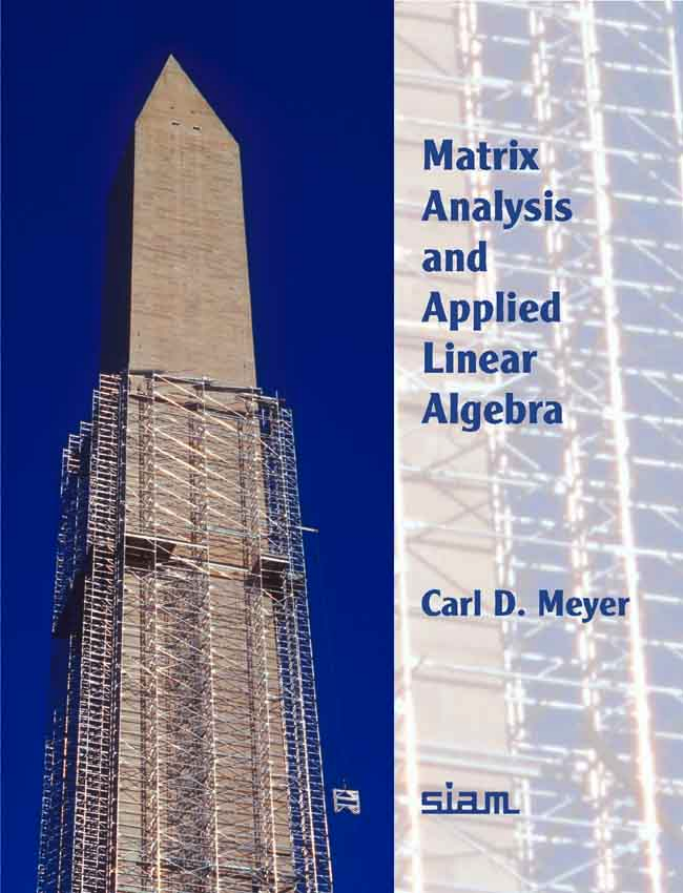
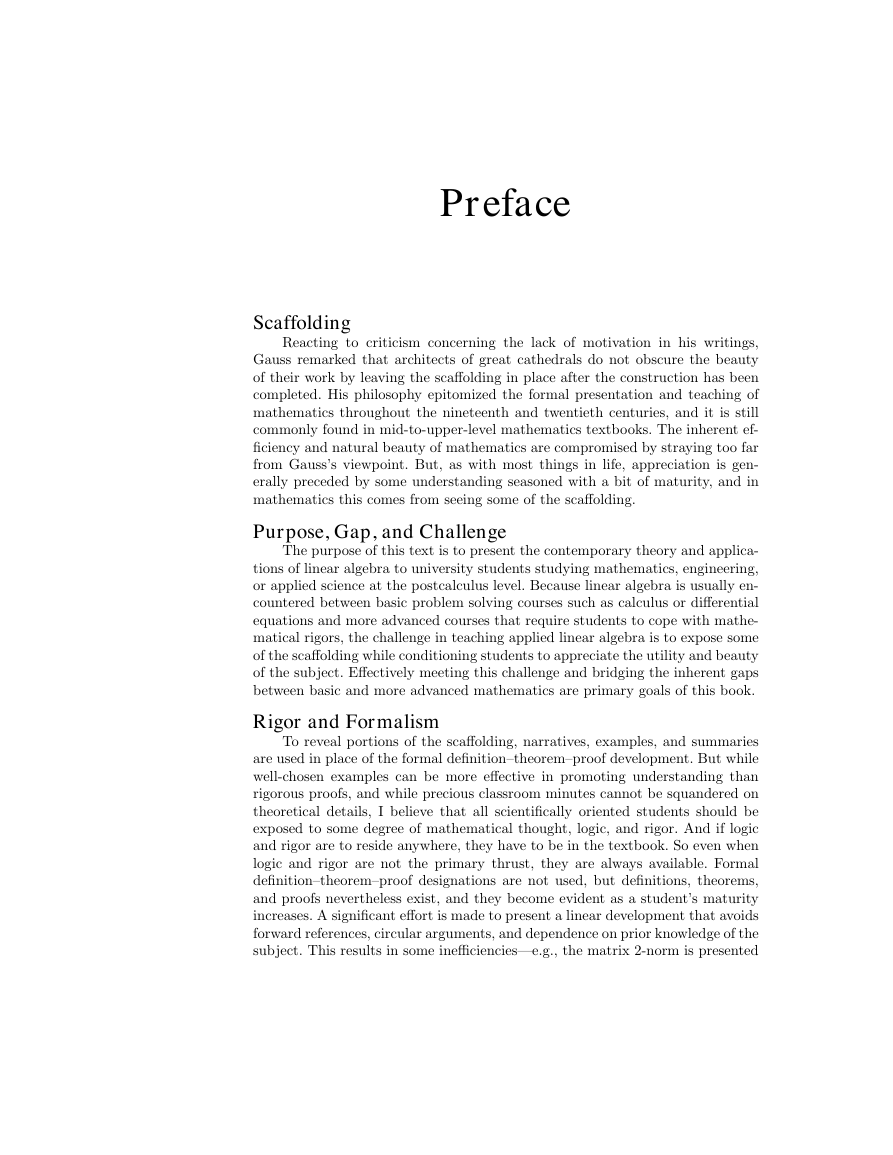
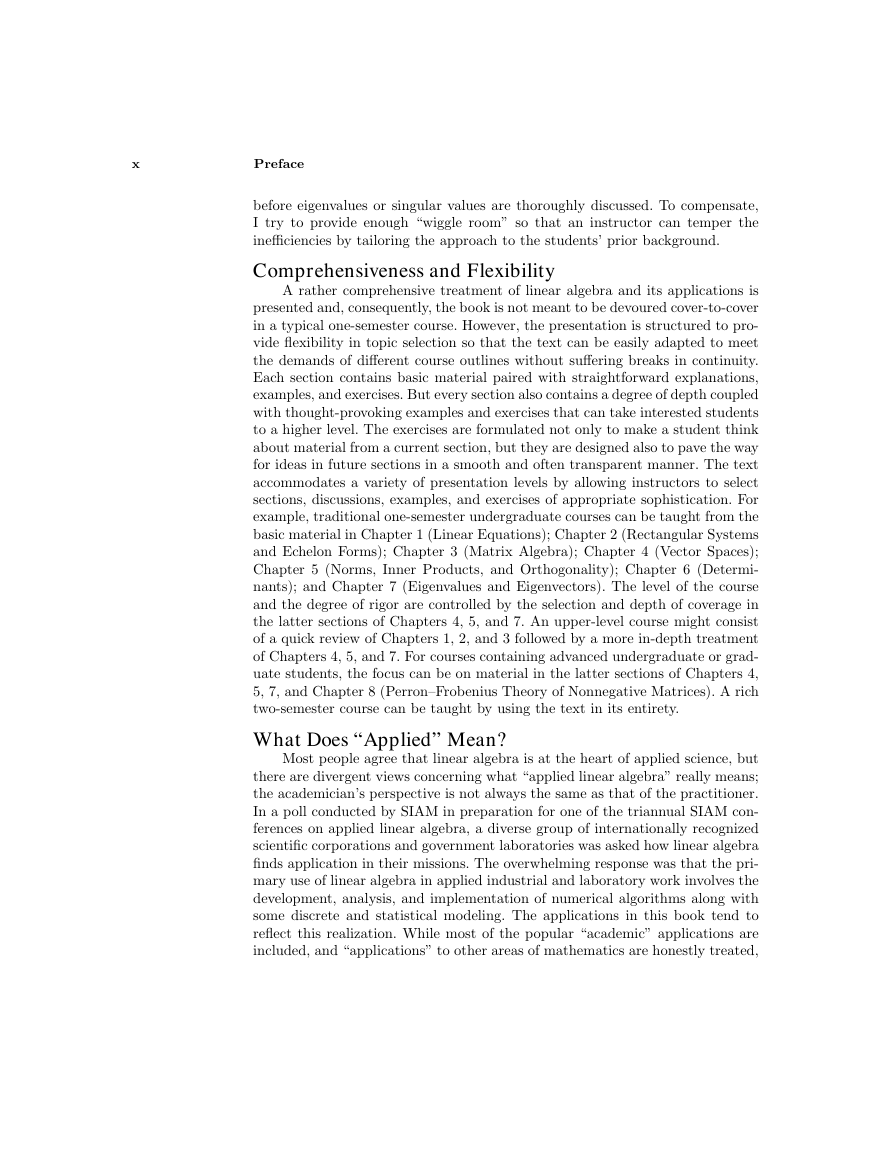
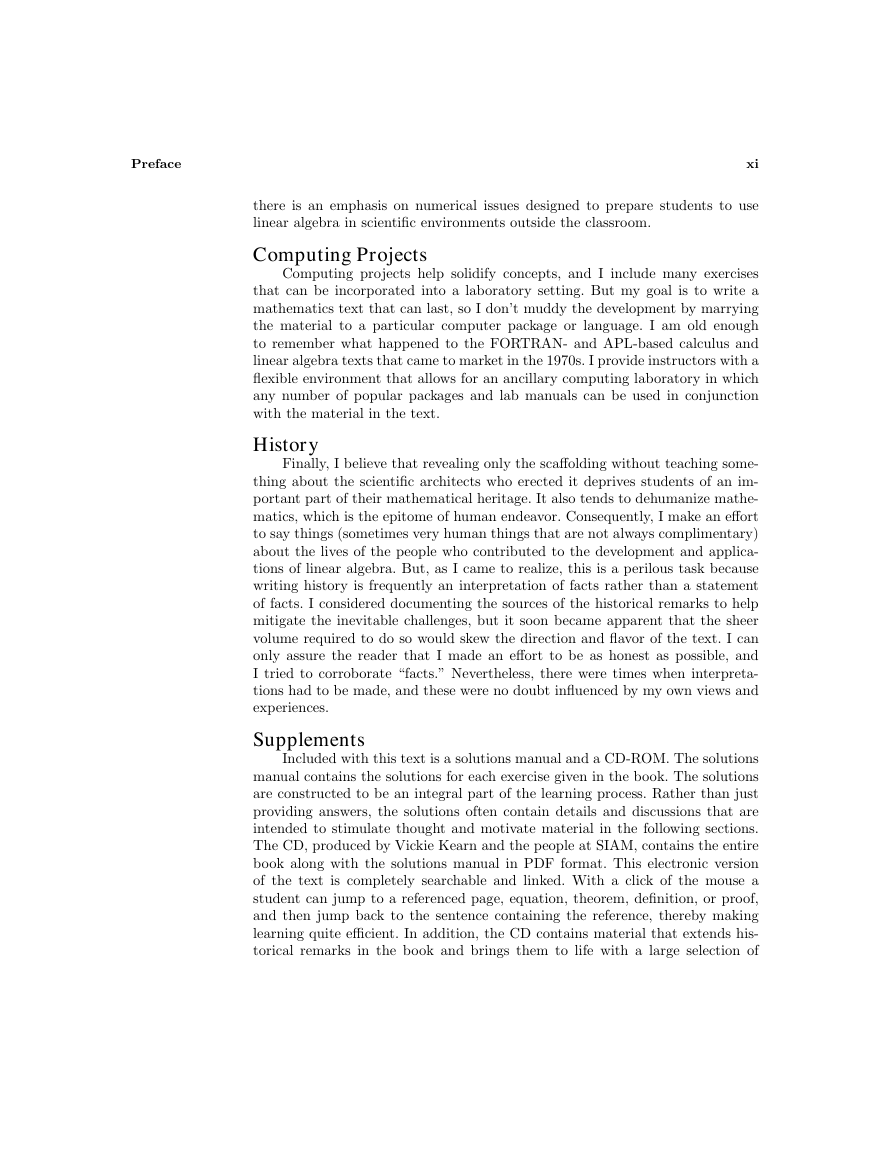
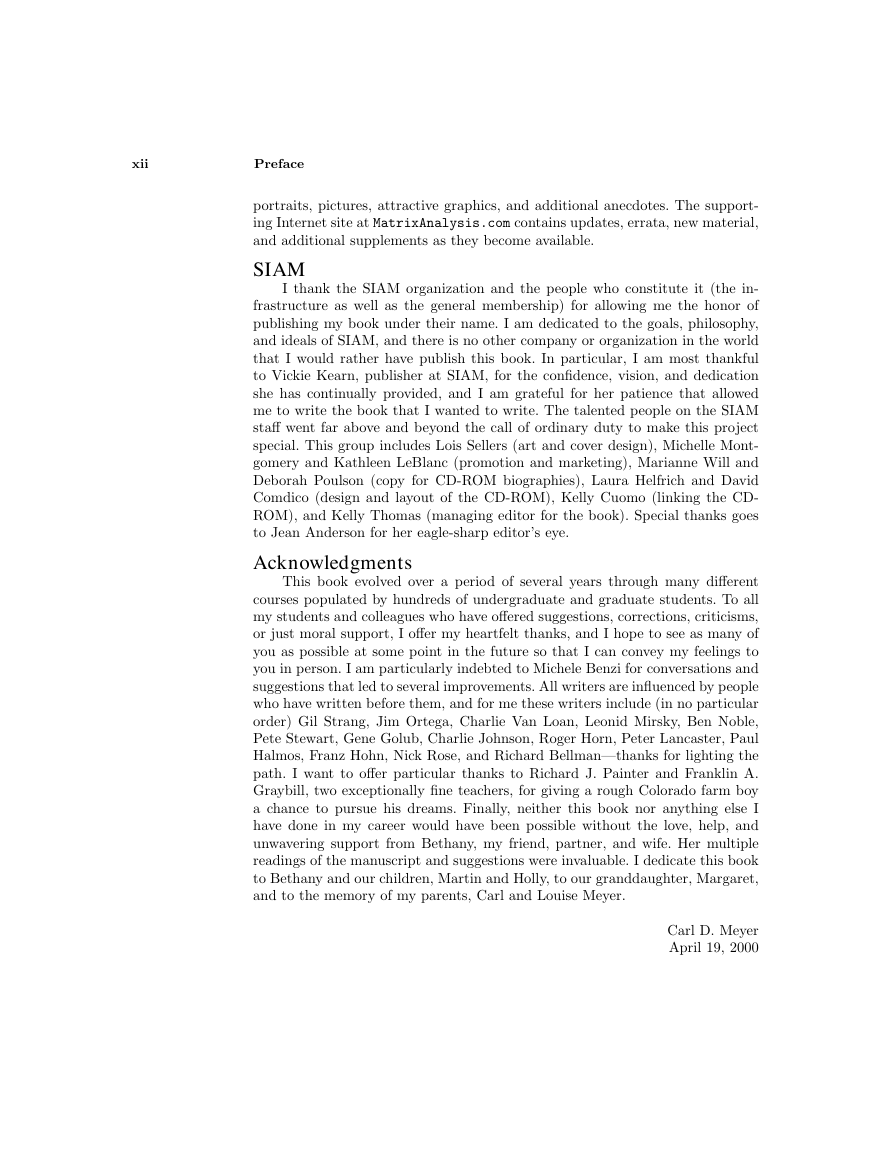
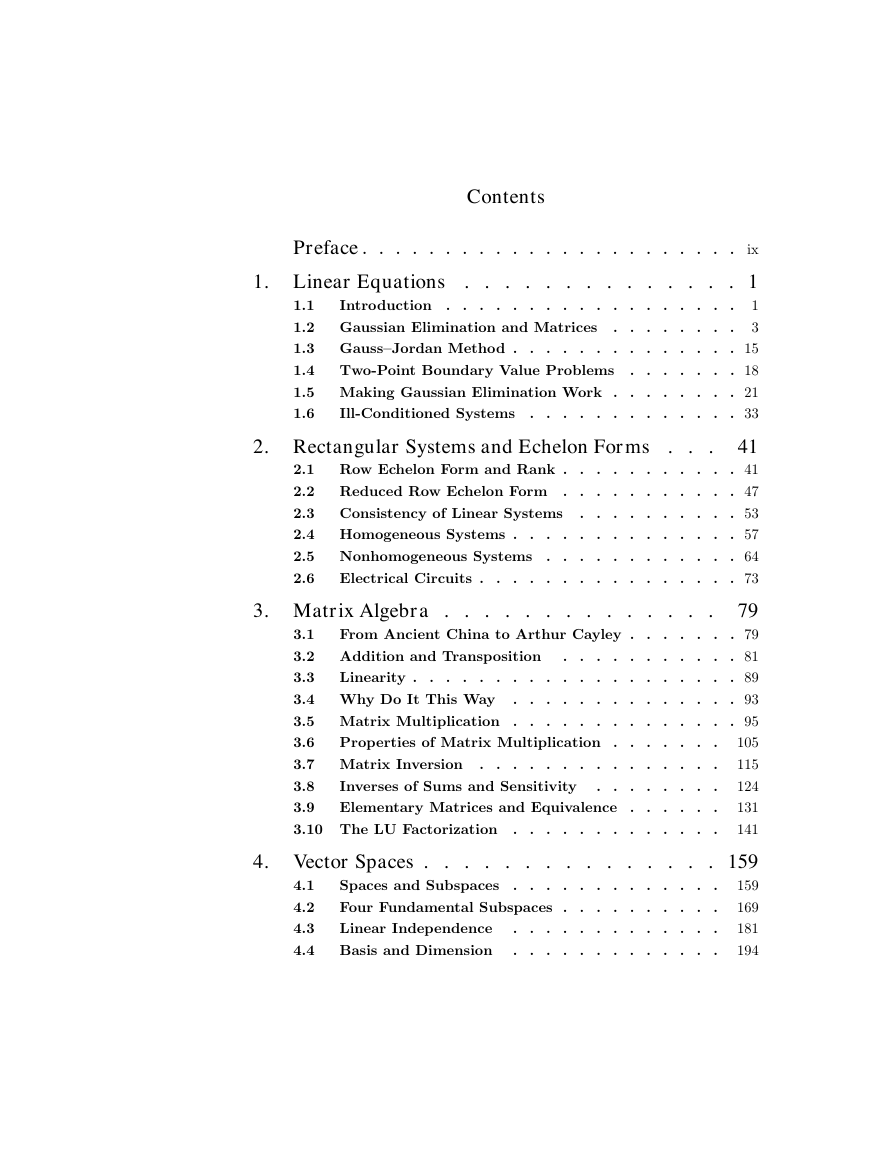
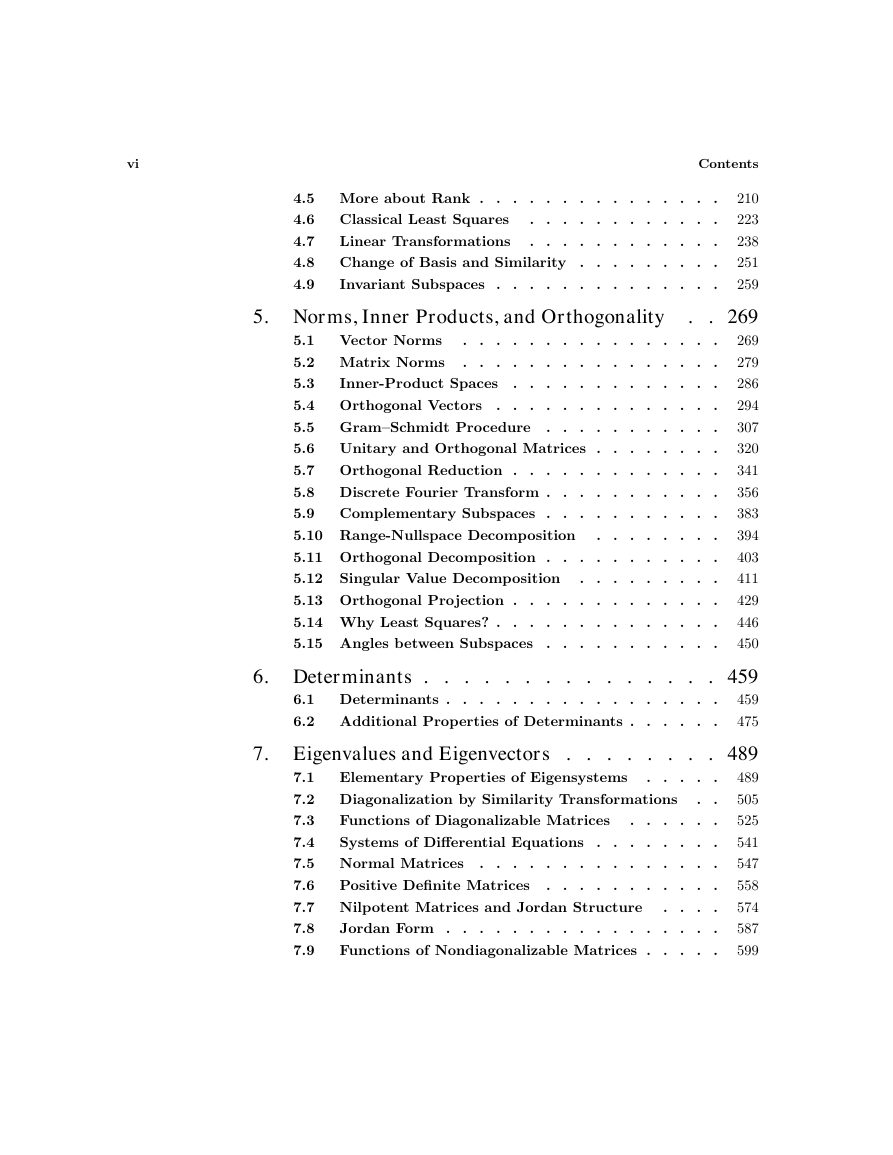
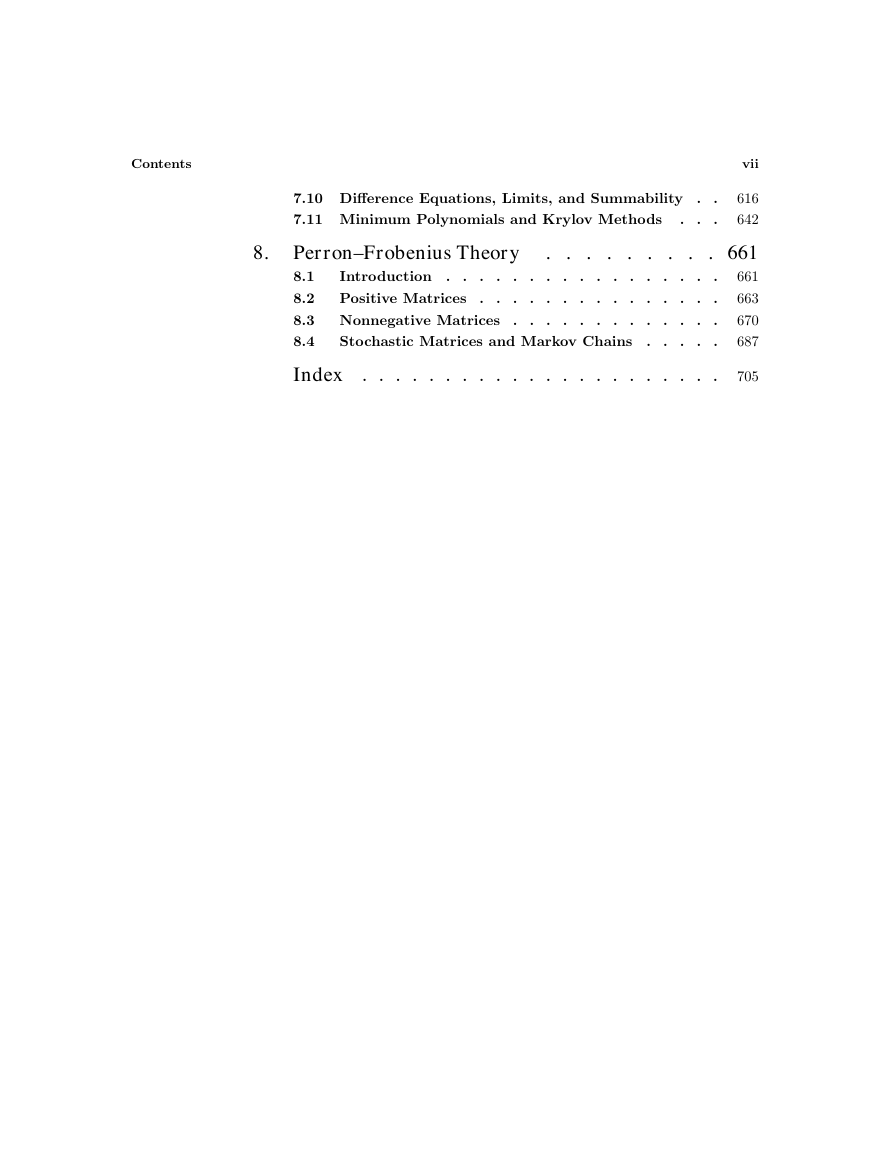








 2023年江西萍乡中考道德与法治真题及答案.doc
2023年江西萍乡中考道德与法治真题及答案.doc 2012年重庆南川中考生物真题及答案.doc
2012年重庆南川中考生物真题及答案.doc 2013年江西师范大学地理学综合及文艺理论基础考研真题.doc
2013年江西师范大学地理学综合及文艺理论基础考研真题.doc 2020年四川甘孜小升初语文真题及答案I卷.doc
2020年四川甘孜小升初语文真题及答案I卷.doc 2020年注册岩土工程师专业基础考试真题及答案.doc
2020年注册岩土工程师专业基础考试真题及答案.doc 2023-2024学年福建省厦门市九年级上学期数学月考试题及答案.doc
2023-2024学年福建省厦门市九年级上学期数学月考试题及答案.doc 2021-2022学年辽宁省沈阳市大东区九年级上学期语文期末试题及答案.doc
2021-2022学年辽宁省沈阳市大东区九年级上学期语文期末试题及答案.doc 2022-2023学年北京东城区初三第一学期物理期末试卷及答案.doc
2022-2023学年北京东城区初三第一学期物理期末试卷及答案.doc 2018上半年江西教师资格初中地理学科知识与教学能力真题及答案.doc
2018上半年江西教师资格初中地理学科知识与教学能力真题及答案.doc 2012年河北国家公务员申论考试真题及答案-省级.doc
2012年河北国家公务员申论考试真题及答案-省级.doc 2020-2021学年江苏省扬州市江都区邵樊片九年级上学期数学第一次质量检测试题及答案.doc
2020-2021学年江苏省扬州市江都区邵樊片九年级上学期数学第一次质量检测试题及答案.doc 2022下半年黑龙江教师资格证中学综合素质真题及答案.doc
2022下半年黑龙江教师资格证中学综合素质真题及答案.doc